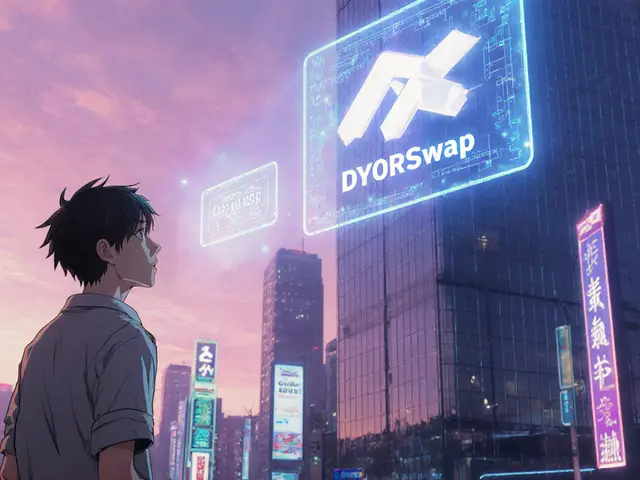SteakBank Finance APY Calculator
Calculate Your Expected Returns
Estimate your potential earnings from SteakBank Finance's liquid staking platform based on validator rewards and DeFi farming yields.
Expected Returns
Based on article data (Oct 2025)Important Risk Disclaimer
The calculator shows potential returns based on data from the article. Actual returns may vary significantly due to:
- Smart contract vulnerabilities (SteakBank Finance has an audit pending as of Oct 2025)
- Validator slashing risk
- Impermanent loss from DeFi farming
- Regulatory changes
- Token launch timing and distribution
Never stake more than you can afford to lose. This is not financial advice.
Ever wonder if that buzz about an SteakBank Finance airdrop is legit or just another meme? You’re not alone. With the crypto world constantly tossing out new token drops, it pays to separate fact from hype before you move any assets. This guide walks you through what SteakBank Finance actually does, how its native SBF token works, what (if anything) is known about an airdrop, and how the platform stacks up against other liquid‑staking projects on the Binance Smart Chain (BSC). By the end you’ll know the risks, the opportunities, and the exact steps to take if you decide to get involved.
What is SteakBank Finance?
SteakBank Finance is a liquid staking platform built on Binance Smart Chain that enables users to lock assets in validator nodes while receiving a tradable derivative token representing the staked position. In plain English, you deposit BNB or other supported tokens, the platform stakes them on your behalf, and you receive an ERC‑20‑style token that you can still trade, lend, or use in other DeFi protocols. The idea is to kill two birds with one stone: you keep earning the usual validator rewards and simultaneously unlock extra yield by deploying the derivative token elsewhere.
How the liquid‑staking mechanism works
The core of SteakBank Finance’s tech lies in its smart contracts (primary contract address 0xBb53…b01734). When you send assets to the contract, it automatically delegates them to a BSC validator. In return, the contract mints a “liquid derivative” token that mirrors your share of the staking pool. These derivative tokens are fully ERC‑20 compatible, meaning you can plug them into any BSC‑based DeFi app - from lending platforms like Venus to automated market makers (AMMs) such as PancakeSwap.
This dual‑revenue model creates two distinct streams:
- Validator rewards: The base yield you’d earn by staking directly, usually a few percent APY depending on network conditions.
- DeFi farming yield: Extra returns you can capture by providing the derivative token as liquidity, lending it out, or using it as collateral.
The magic is that you don’t have to pick one or the other - both happen simultaneously, boosting overall capital efficiency.
SBF tokenomics at a glance
The native token, ticker SBF, has a hard cap of 10billion tokens. As of the latest on‑chain data, zero tokens are in active circulation, suggesting the project is still in pre‑launch or early distribution mode. Key token attributes include:
- Total Supply: 10billion SBF
- Circulating Supply: 0 (pre‑launch)
- Utility: Governance voting, fee discounts, staking reward boosts, and collateral in partnered DeFi protocols
- Distribution Plan: Not publicly disclosed - the team has hinted at a mix of community incentives, validator rewards, and a potential airdrop.
Because the token isn’t trading yet, price speculation should be taken with a grain of salt. Watch official channels for a token launch announcement before making any assumptions about value.

What we know about the SBF airdrop
Despite the hype, the official SteakBank Finance documentation does not currently list a confirmed airdrop program. The absence of a clear allocation mechanism, eligibility criteria, or distribution schedule means any airdrop claims you see on social media are likely speculative.
That said, the team has hinted at rewarding early community members once the token goes live. Typical eligibility factors in similar projects include:
- Holding a minimum amount of the platform’s derivative token for a set period
- Providing liquidity on designated AMM pairs
- Participating in governance votes or testnet activities
Until the project releases an official statement, we recommend:
- Following the official Telegram, Discord, and Twitter accounts for verified updates.
- Avoiding any “airdrop farming” services that ask for private keys or upfront fees.
- Using only the official contract address (0xBb53…b01734) to interact with the platform.
Competitive landscape: How SteakBank stacks up
Several other liquid‑staking solutions already operate on BSC. Below is a quick side‑by‑side look at three notable projects: SteakBank Finance, pSTAKE Finance, and Ankr Staking.
| Feature | SteakBank Finance | pSTAKE Finance | Ankr Staking |
|---|---|---|---|
| Primary Chain | Binance Smart Chain | Binance Smart Chain | Binance Smart Chain |
| Liquidity Token Type | Custom derivative (SBF‑LP) | pSTAKE‑BSC | ANk‑BSC |
| Validator Reward APY (approx.) | 4‑6% | 5‑7% | 4‑5% |
| DeFi Farming Integration | Built‑in yield farms | Partner farms via pSTAKE Vaults | Limited to external AMMs |
| Token Supply | 10B (SBF) - pre‑launch | 1B (PSTAKE) - circulating | 600M (ANKR) - circulating |
| Audit Status | Audit pending (as of Oct2025) | Audited by CertiK | Audited by PeckShield |
SteakBank Finance’s unique angle is the emphasis on multi‑stream revenue - a built‑in farm that automatically deploys the derivative token for additional yield. However, it currently lacks a public audit, which is a red flag compared to the more vetted competitors.
Risk assessment and due‑diligence checklist
Every DeFi project carries inherent risk, and SteakBank Finance is no exception. Here are the main categories you should evaluate before committing funds:
- Smart‑contract risk: Bugs or exploits in the staking contracts could result in loss of principal. Look for an audit report and community audit findings.
- Validator slashing: If the chosen validator misbehaves, a portion of the staked assets can be burned. Verify how SteakBank selects and monitors its validators.
- Impermanent loss: Supplying the derivative token to AMMs can expose you to price swings relative to the underlying asset, reducing net returns.
- Regulatory uncertainty: Some jurisdictions treat liquid staking derivatives as securities. Ensure your local rules permit participation.
- Token launch timing: With zero circulating supply, the eventual token release could drastically affect tokenomics and price.
Use the following quick checklist:
- Confirm the contract address (0xBb53…b01734) on BscScan.
- Check for an independent audit - if none, proceed with a minimal amount.
- Review community channels for recent activity (Telegram, Discord, Twitter).
- Calculate expected APY by adding validator rewards + average farming yield on the platform’s farms.
- Set a clear risk tolerance - never stake more than you can afford to lose.

Step‑by‑step: Getting started if you decide to join
If you’ve done your research and want to try the platform, follow these basic steps:
- Set up a BSC‑compatible wallet: MetaMask, Trust Wallet, or Binance Chain Wallet work fine. Make sure you’re on the BSC mainnet.
- Acquire BNB (or supported asset): You’ll need BNB for staking and a small amount of BNB to cover gas fees.
- Add the contract: In your wallet, add the staking contract address 0xBb53…b01734 as a custom token. This lets you see the derivative token balance.
- Stake your assets: Use the official SteakBank Finance UI (link from the verified Twitter bio). Enter the amount you wish to stake and confirm the transaction.
- Track rewards: The UI shows both validator rewards and any secondary farming yields. You can claim or re‑invest as desired.
- Stay updated: Subscribe to the official announcement channel for any airdrop news, token launch dates, or protocol upgrades.
Remember, the moment you interact with any smart contract you’re exposing yourself to risk. Start with a small test amount, verify that rewards appear as expected, then scale up if everything looks solid.
Key takeaways
SteakBank Finance aims to combine traditional staking with DeFi yield farming on BSC, offering users a liquid derivative token that can be traded or used elsewhere. The native SBF token is still unreleased, and no official airdrop details have been published - so speculation is high. Compared with pSTAKE Finance and Ankr Staking, SteakBank’s biggest advantage is its built‑in multi‑stream revenue, but its lack of an audit and zero circulating supply increase uncertainty. Anyone considering the platform should perform thorough due‑diligence, start with a modest amount, and keep an eye on official communications for a possible token launch and airdrop announcement.
Frequently Asked Questions
Is there an official SteakBank Finance airdrop right now?
No. As of October2025 the project has not published any confirmed airdrop schedule, eligibility rules, or distribution amounts. Watch the official channels for future announcements.
How does the liquid derivative token differ from the original asset?
The derivative token represents your share of the staking pool and can be moved, traded, or used as collateral, while the underlying asset remains staked and locked in a validator. This gives you both staking rewards and the ability to earn extra DeFi yield.
What are the main risks of using SteakBank Finance?
Key risks include smart‑contract vulnerabilities (no public audit yet), validator slashing, impermanent loss when farming with the derivative token, and regulatory uncertainty around liquid staking derivatives.
How can I start staking on SteakBank Finance?
Set up a BSC‑compatible wallet, obtain BNB, add the contract address 0xBb53…b01734, and deposit your funds via the official UI. After the transaction confirms, you’ll receive the liquid derivative token.
Will the SBF token be listed on major exchanges?
There is no official listing information yet. Once the token launches and a liquidity pool is created, the team may seek listings on Binance, PancakeSwap, or other BSC‑focused exchanges.



Bobby Lind
October 17, 2025 AT 09:27Wow, this platform blends staking and farming in a way that feels fresh, the token mechanics look promising, and the community vibe is upbeat, so keep your expectations realistic, stay diversified, and have fun exploring!
Katharine Sipio
November 8, 2025 AT 21:27I commend the detailed breakdown; it offers a practical guide for beginners seeking to allocate capital responsibly.
Shikhar Shukla
December 1, 2025 AT 09:27The proposal presents an intriguing model, yet the lack of a publicly verified audit constitutes a substantial risk factor that cannot be ignored.